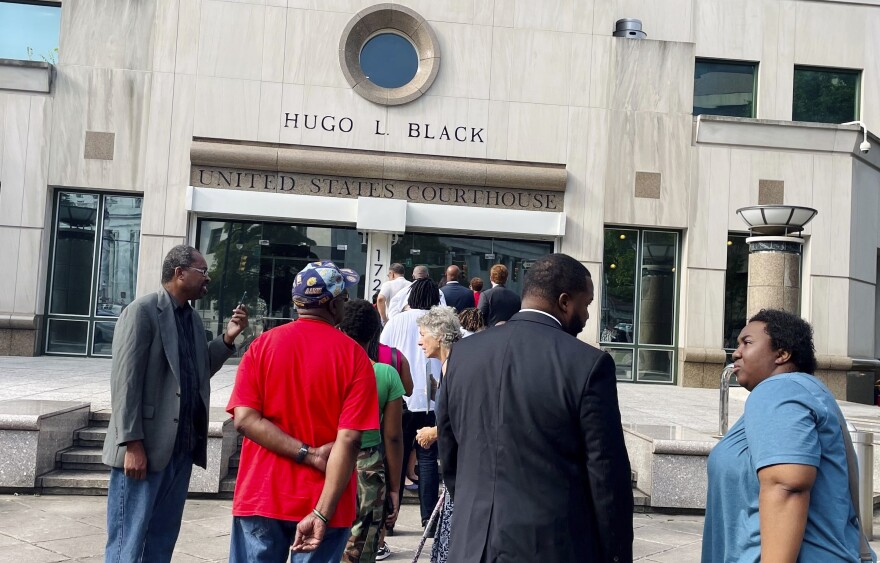BIRMINGHAM, Ala. — The lines on Alabama's congressional map have shifted — along with some of the state's political power.
After a high-profile legal fight that lasted roughly two years, a panel of three federal judges on Thursday picked a map that will be used when Alabamians cast their 2024 vote for who will represent them in the U.S. House.
The new map adds a second congressional district where Black voters' preferred candidate is projected to win a majority of the time.
That's a win for Black Alabamians — and Democrats, who tend to receive those votes.
It's a loss for Republican leaders in Alabama who were twice rebuked by the U.S. Supreme Court.
And the shift in Alabama of one seat toward Democrats' favor could be repeated in other states, as the precedent set with Alabama's case is affecting similar redistricting cases elsewhere. That could make the GOP's slim majority in the U.S. House harder to hold next year.
BREAKING: A federal court has ordered Alabama to use this congressional map for the 2024 elections. It includes two districts (No. 2 and 7) where Black Alabamians have a realistic opportunity to elect their preferred candidate, likely Democratshttps://t.co/khPlUBVPyw pic.twitter.com/JJtnVaNczW
— Hansi Lo Wang (he/him) (@hansilowang) October 5, 2023
Back to the cartography board
The legal tug-of-war over Alabama's congressional map started shortly after the state redrew its districts in 2021. Despite Black Alabamians making up 27% of the state's population, only one of the state's seven congressional seats regularly went to a candidate preferred by Black voters.
But a three-judge panel ruled in 2022 that the state likely violated the Voting Rights Act by diluting Black political power. The judges said Alabama needed to make a second majority-Black district or "something quite close to it."
Alabama appealed to the Supreme Court. The justices decided the state could at least use the new map it drew for the 2022 elections while waiting on a final decision from the high court. That move, combined with the court's strong conservative majority, made it seem likely the justices would side with Alabama and further weaken the Voting Rights Act.
Instead, in June the Supreme Court backed the lower court, with both Chief Justice John Roberts and Justice Brett Kavanaugh siding with the court's three liberals.
Alabama's defiance
The Supreme Court put the pen back in Republican legislators' hands to redraw the state's congressional map with a clear mandate: Make a second district that empowers Black voters.
Instead, lawmakers passed another map that only marginally increased Black voters' share in a second district.
Once again, the same three-judge panel reviewed Alabama's map. The state argued that this was a new map, passed along new rules, so the old order should not apply. Besides, the state said considering race when drawing the map would have been racial gerrymandering and therefore illegal.
The judges were not swayed. In their decision, they said they were "disturbed" by Alabama's actions and the state failing to "even nurture the ambition" to follow the court's Supreme Court-backed order.
This time, the judges decided not to give Alabama lawmakers another chance at mapmaking. The panel assigned a special master to work with a cartographer to deliver three potential maps. The Supreme Court rejected Alabama's request for an appeal.
While the plaintiffs largely supported two out of the three maps, the Alabama Democratic Conference said none of the options provided enough power for Black voters. Based on the party's analysis, a white candidate preferred by Black voters could win under any of the maps, but a Black candidate would struggle.
On Thursday, the judges decided to enforce the third map drawn by the special master. The map doesn't include a second majority-Black district. District 2 has a Black voting-age population of 48.7%. But it did outperform the other two choices, with the Black-preferred candidate winning 16 of the 17 previous elections, according to the special master's analysis.
How those projections hold up will be tested soon, with the map set to be used for the upcoming 2024 election.
In their ruling Thursday, the three-judge panel wrote that "this plan satisfies all constitutional and statutory requirements while hewing as closely as reasonably possible to the Alabama Legislature's 2023 Plan."
Drawing outside the state lines
The June decision by the Supreme Court has spread beyond Alabama to other southern states with their own redistricting cases.
There are similar cases against Republican-drawn congressional maps in states including Florida, Georgia and Louisiana.
The Florida case is in response to Gov. Ron DeSantis leading GOP lawmakers last year to draw a map eliminating a voting district in North Florida with a large Black population.
In Georgia, a federal judge has already stated that parts of the state's maps likely violate federal law. Still, he's running a trial to flesh out the facts.
A federal court has also already ruled that Louisiana diluted Black voting power in the state. An appeals court has stopped the redrawing of Louisiana's map, delaying the process there.
And the U.S. Supreme Court is set to hear oral arguments in a South Carolina gerrymandering case on Oct. 11.
Copyright 2024 Gulf States Newsroom. To see more, visit .

